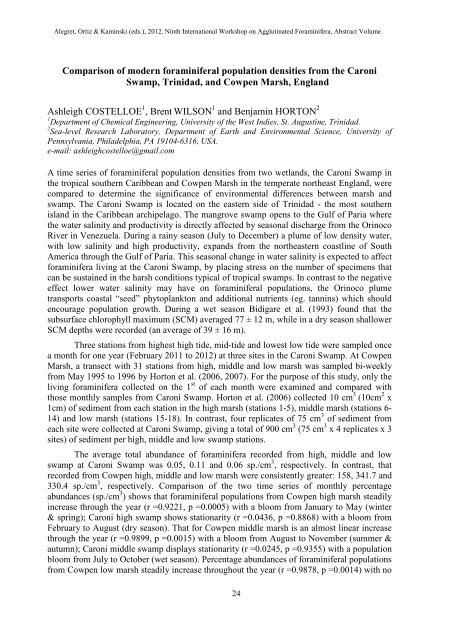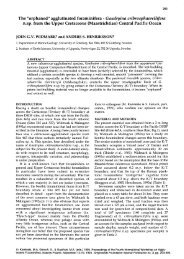Full Text | Download - Grzybowski Foundation - The ...
Full Text | Download - Grzybowski Foundation - The ...
Full Text | Download - Grzybowski Foundation - The ...
You also want an ePaper? Increase the reach of your titles
YUMPU automatically turns print PDFs into web optimized ePapers that Google loves.
Alegret, Ortiz & Kaminski (eds.), 2012. Ninth International Workshop on Agglutinated Foraminifera, Abstract Volume<br />
Comparison of modern foraminiferal population densities from the Caroni<br />
Swamp, Trinidad, and Cowpen Marsh, England<br />
Ashleigh COSTELLOE 1 , Brent WILSON 1 and Benjamin HORTON 2<br />
1 Department of Chemical Engineering, University of the West Indies, St. Augustine, Trinidad.<br />
2 Sea-level Research Laboratory, Department of Earth and Environmental Science, University of<br />
Pennsylvania, Philadelphia, PA 19104-6316, USA.<br />
e-mail: ashleighcostelloe@gmail.com<br />
A time series of foraminiferal population densities from two wetlands, the Caroni Swamp in<br />
the tropical southern Caribbean and Cowpen Marsh in the temperate northeast England, were<br />
compared to determine the significance of environmental differences between marsh and<br />
swamp. <strong>The</strong> Caroni Swamp is located on the eastern side of Trinidad - the most southern<br />
island in the Caribbean archipelago. <strong>The</strong> mangrove swamp opens to the Gulf of Paria where<br />
the water salinity and productivity is directly affected by seasonal discharge from the Orinoco<br />
River in Venezuela. During a rainy season (July to December) a plume of low density water,<br />
with low salinity and high productivity, expands from the northeastern coastline of South<br />
America through the Gulf of Paria. This seasonal change in water salinity is expected to affect<br />
foraminifera living at the Caroni Swamp, by placing stress on the number of specimens that<br />
can be sustained in the harsh conditions typical of tropical swamps. In contrast to the negative<br />
effect lower water salinity may have on foraminiferal populations, the Orinoco plume<br />
transports coastal “seed” phytoplankton and additional nutrients (eg. tannins) which should<br />
encourage population growth. During a wet season Bidigare et al. (1993) found that the<br />
subsurface chlorophyll maximum (SCM) averaged 77 ± 12 m, while in a dry season shallower<br />
SCM depths were recorded (an average of 39 ± 16 m).<br />
Three stations from highest high tide, mid-tide and lowest low tide were sampled once<br />
a month for one year (February 2011 to 2012) at three sites in the Caroni Swamp. At Cowpen<br />
Marsh, a transect with 31 stations from high, middle and low marsh was sampled bi-weekly<br />
from May 1995 to 1996 by Horton et al. (2006, 2007). For the purpose of this study, only the<br />
living foraminifera collected on the 1 st of each month were examined and compared with<br />
those monthly samples from Caroni Swamp. Horton et al. (2006) collected 10 cm 3 (10cm 2 x<br />
1cm) of sediment from each station in the high marsh (stations 1-5), middle marsh (stations 6-<br />
14) and low marsh (stations 15-18). In contrast, four replicates of 75 cm 3 of sediment from<br />
each site were collected at Caroni Swamp, giving a total of 900 cm 3 (75 cm 3 x 4 replicates x 3<br />
sites) of sediment per high, middle and low swamp stations.<br />
<strong>The</strong> average total abundance of foraminifera recorded from high, middle and low<br />
swamp at Caroni Swamp was 0.05, 0.11 and 0.06 sp./cm 3 , respectively. In contrast, that<br />
recorded from Cowpen high, middle and low marsh were consistently greater: 158, 341.7 and<br />
330.4 sp./cm 3 , respectively. Comparison of the two time series of monthly percentage<br />
abundances (sp./cm 3 ) shows that foraminiferal populations from Cowpen high marsh steadily<br />
increase through the year (r =0.9221, p =0.0005) with a bloom from January to May (winter<br />
& spring); Caroni high swamp shows stationarity (r =0.0436, p =0.8868) with a bloom from<br />
February to August (dry season). That for Cowpen middle marsh is an almost linear increase<br />
through the year (r =0.9899, p =0.0015) with a bloom from August to November (summer &<br />
autumn); Caroni middle swamp displays stationarity (r =0.0245, p =0.9355) with a population<br />
bloom from July to October (wet season). Percentage abundances of foraminiferal populations<br />
from Cowpen low marsh steadily increase throughout the year (r =0.9878, p =0.0014) with no<br />
24



